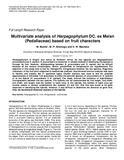Multivariate analysis of Harpagophytum DC. ex Meisn (Pedaliaceae) based on fruit characters

View/
Date
2011Author
Muzila, M.
Setshogo, M.P.
Mpoloka, S.W.
Publisher
Academic Journals; http://www.academicjournals.org/ijbcType
Published ArticleMetadata
Show full item recordAbstract
Harpagophytum is bitypic and native to Southern Africa. Its two species are Harpagophytum
procumbens and H. zeyheri. H. procumbens is medicinal. A reliable method of identifying the species is through its fruit. However, distinguishing between H. procumbens and H. zeyheri can be difficult
because of the various morphotypes. Hence, possibilities of introgression are hypothesized. The
objective of this study was to test for interspecific introgression between the two species. Diagnostic
characters of the fruit were subjected to multivariate analysis. Discriminant function analysis was used to identify and classify the 21 specimen types. Cluster analysis was used to test for possible
appurtenance of individual fruit specimens to either the parental species (H. procumbens or H. zeyheri)
or to the hybrid (H. procumbens X H. zeyheri). The study inferred the existence of hybridisation
(introgression) between the two species. The hybrids can be characterised by fruit length, fruit width, arm width, arm length, and the number of seed rows. In the hybrids, the number of seed rows per
loculus comes in various combinations (for example 3,3 and 3,2). And this was found to be quite
important in identifying the hybrids. However, it was difficult to determine the direction of gene flow, thus, we recommend molecular analysis of the hybrids.
